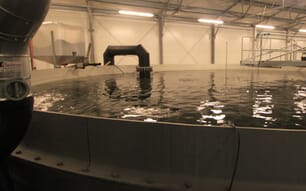The FISHBOOST project is improving selective breeding for six species – Atlantic salmon, common carp, European seabass, gilthead seabream, rainbow trout and turbot – while taking stock of social and industry views on acceptability and costs. The project involves no genetic modification, just a mixture of modern and traditional breeding methods.
One year into the five-year project, researchers have already tested families of fish that could breed disease resistance, preventing rather than curing sickness.
Next steps include identifying the DNA linked to disease-resistance in these families, and using new DNA-based methods to select individuals to become parents of the next generation.
The team is also developing software that uses genetic data to help choose parent fish for improved stocks, while further research is identifying fish with traits for more efficient fillet-production.
Improving industry
"There is little breeding in European aquaculture and we want to make it better by improving ways to measure traits and develop more accurate selection methods," said project coordinator Anna Sonesson from the Norwegian Institute of Food, Fisheries and Aquaculture research (Nofima).
“All work is done in close collaboration between research and industry – this is essential for a project like FISHBOOST," explained Ms Sonesson.
By working with industry and other stakeholders, including animal welfare groups, researchers intend to show how advanced selective breeding technology can improve the efficiency and sustainability of European aquaculture.
Identifying fish through DNA can help strengthen traits that traditional selection methods find difficult to improve. The project’s work already shows that selective breeding can protect wild fish from diseases prevalent in farms and generally improve aquaculture fish health, while reducing costs for producers.
The project is also identifying fish that best use feed – difficult to predict in fish, who feed irregularly and whose individual feed intake cannot easily be measured. Indirect selection methods are being developed to pinpoint families for this trait.
Similarly, FISHBOOST is evaluating fish from the same populations for efficient fillet production, to produce muscle rather than fat to appeal to consumers, and for adaptation to new diets.
Meeting demand
According to EU data, aquaculture is becoming more important for seafood production than wild fisheries, due to a growing world demand for animal protein.
With only 10 per cent of the world’s aquaculture production using genetically improved stock – and large differences in practices within Europe – the fast-growing industry could benefit from blending traditional and new breeding methods.
The project selects breeding fish that have the best gene variants of the populations they look at.
“We are increasing our knowledge of the genetics behind the traits we want,” said Ms Sonesson.
This involves studying DNA samples from thousands of fish, Ms Sonesson explained: “In order to select parents, we must use a lot of families to ensure enough genetic variation.”
As part of its hi-tech approach, FISHBOOST is developing DNA-based software to select breeding fish for new breeding programmes.
Because fish produce many more offspring than land-based species, it is easier to select for particular traits.
However, it is essential to control inbreeding to keep the fish population healthy, so researchers are developing IT-based methods to do so that take account of the specific biology of the fish. The project team will make the software available for free.
“We will also try to quantify the value of breeding to producers,” said Ms Sonesson, while a report on social perceptions of aquaculture breeding addresses ethical considerations.
Many of the project partners are part of the European Aquaculture Technology and Innovation Platform (EATIP) and the Farm Animal Breeding and Reproduction Technology Platform (FABRE-TP).
“Our aim is to boost the industry with efficient breeding programmes, whereby hi-tech tools and methods boost traditional approaches,” said Ms Sonesson.
“We are very happy with the start of FISHBOOST, and the work that has been done so far, which puts us on track with the project. We have a good basis for the coming work up to 2019.

